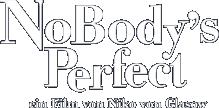A Crazy Project
What has possessed me - a balding, big-bellied German Thalidomide man - to want to become a nude photographic model? I look like a pink, tubby, bespectacled penguin, and because of my little arms I can’t even bring myself to take my shirt off on the beach. And yet I’ve persuaded myself and eleven other first-time models, who share my disability, to strip naked and pose for me.
The idea was to take a series of honest, beautiful photographs which I could exhibit, and put into a film and a book. So I had to find my unwitting victims and use my non-existent charm to persuade them to take part in this crazy project. And I had to find the courage to expose myself, look at myself, and accept the truth that NoBody’s Perfect.
Up till the point in my life where the film starts, I’d been happy to avoid confronting my disability and body image. I hadn’t addressed disability in my filmmaking, and I’d been determined not to think of myself as different from everyone around me. So what if I can’t do press-ups, tie my shoelaces or carry pianos up flights of stairs? The missionary position isn’t the only way to make love. I could get through life just fine without these things.

But a fact I couldn’t deny is that when people see me, the first thing they respond to is the way I look. Even if they don’t say anything, they react. Some stare, but most look away politely, determined not to show they’ve noticed, or hide their embarrassment by violently scratching imaginary itches on their noses. And I could hardly blame them. I’ve always been deeply uncomfortable about it myself. At least my younger days of cape-wearing self-consciousness are far behind me now, and I and my short arms are a familiar sight on the film festival circuit and on the streets near my home. But I know many disabled people who are reluctant or unable to go out in public, for fear of the disgusted, confused, amused or pitying stares they’ll encounter. And these are the people I want to turn into nude models!

Many years ago, I had the idea of taking a series of beautiful nude photos of disabled people. My psychiatrist advised me only to do it if I was prepared to strip for the camera myself. This horrified me into dropping the idea, and it might have stayed dropped forever except that the German TV company WDR invited me to make a personal, original and funny documentary about people affected by Thalidomide. I was far from enthusiastic. I’m a serious (by which I mean grumpy, temperamental and unpredictable) filmmaker who values his privacy and does his best to forget his disability. Why should I want to make a film about Thalidomide, and how the hell would I make it funny?
But the invitation must have come at a point in my life where I was realising I couldn’t – or shouldn’t – keep denying my disability and distancing myself from those who share it. If I want people to stop staring, maybe I have to let them get it out of their systems and give them something to stare at. And force myself to do some good hard staring too.
It wasn’t just a question of taking the photos. I had to exhibit them, and record the reactions of the art world and the general public, as well as of the models themselves. Then I wanted to produce a book of the photos – but would anyone buy it? Anyway, first things first – I needed my models.
Thalidomide was sold in almost every country of the world. At least 10,000 babies were affected worldwide, of whom 4000 died before reaching their first birthdays. The drug was made by a German company, Chemie Grünenthal, and around 5000 German Thalidomide babies were born – I’m one of the surviving 2,800. As Germany and the UK were two of the highest-affected countries, and as I live and work in both, these are the places where I based the project.

